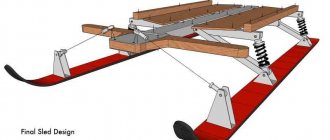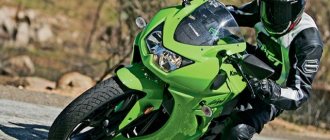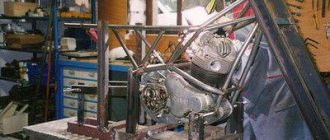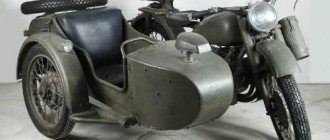000_MOTO_1110_060
First of all, Yuri, I would like to congratulate you once again - on my own behalf and on behalf of the Moto readers - on, dare I say it, a triumphant performance in Sturgis.
Well, if you really want to...
Here's the thing. Could you answer a few questions? Shed some light, so to speak, and lift the veil.
To be honest, I don’t even know... There’s a lot of work, you know...
What if it’s like this?..
Put it here in the corner. So, where should we start our frank and thorough conversation? By the way, you don’t have to rush - I don’t have anything else planned for today.
Thank you. So let's get started. Let me tell you, did your success in Sturgis come as a pleasant but still unexpected surprise?
It was nice - yes, what can I say. But I wouldn’t say anything about surprise. I don’t want to seem overly self-confident, but the victory at the World Championships became for me more of a logical conclusion to long and painstaking work than “out of the blue.” We built The Machine with a specific goal - to "make" America. And everything was subordinated to this great idea, which, fortunately, the customer fully shared with us.
And who is this brave hero?
Well-known in biker circles, Evgeniy Icebreaker from the Moscow “Bastards” is a man whose main activity is so secret that sometimes it becomes scary.
You're right - I'm already scared.
Note that it was fundamentally important to “shoot” in America with something “ours,” frankly un-American. And what could be dearer than the opposition?
Many - yes, many, almost all! — domestic customizers started with opposed ones. And you, it turns out, have only just matured to them?
Yes, and it makes perfect sense. After all, what kind of example have we set for young guys lately? It seems like if you don’t have an American V-twin to build a custom bike, then there’s no point in getting involved in the scrap row? This is a completely wrong situation! This is what I wanted to change - to show that the heights of world customization can be achieved using domestic engines.
And in order to “shoot,” as you put it, in one gulp, it was decided to double the number of cylinders?
“Double the number of cylinders” sounds like it's a piece of cake. In general, it is a deep misconception to consider The Machine a twin-engine motorcycle. In essence, this is a motorcycle with the original 1.5-liter four-cylinder “boxer”, built using parts from two K-750 engines.
I agree, it would be indecently incorrect to say that The Machine has two CASIC engines stupidly installed one behind the other. Not only are the engines fused with crankcases, but also the rear pair of cylinders is “reversed” (more precisely, the left and right cylinders have swapped places). It looks like you had to solve not the simplest engineering problem?
Absolutely right. And the new camshaft is far from the only thing that had to be developed and manufactured specifically for this power unit. Not to mention the ignition system and so on... In fact, when at the very beginning of the project I explained to our permanent chief mechanic and minder Dmitry Lobank what we needed to do with the engine for this motorcycle, he directly told me that it was impossible to do. To the question “Why?” he replied: “Because it is impossible to do at all!”
Well?
Well, they did it, as you can see. True, Dimos almost went bald because of this. In short, don't try this at home.
The Roots Brothers mechanical supercharger looks like it was made for this bike. Where, if it’s not a secret, was this beauty borrowed from? And does it create the atmosphere properly?
This is a modified Mercedes "compressor". It pumps with terrible force. (What is the question, as they say, is the answer.)
I wonder if there is anything American about this motorcycle?
Let me think. Oddly enough, there is. Screamin' Eagle carburetor.
007_MOTO_1110_060
Okay, that forgives me. Now let's talk about the “philosophy” or, if you like, the “ideology” of the project.
The cornerstone of The Machine’s “philosophy” is that this motorcycle was created using classic technologies and engineering solutions from seventy years ago - that is, theoretically, it could have been built not today, but seventy years ago.
Zeitgeist?
Dmitry, please don’t express yourself! By the way, my children also work in my workshop.
I mean that there is such a term - “zeitgeist”, “spirit of the time” from German, which is usually used to designate, if briefly according to Hegel, “a set of ideas characteristic of a certain era.”
Ah, well, if according to Hegel, then yes - a complete “zeitgeist”!
But the image turned out to be truly collective. And it evokes not only motorcycle, but also automobile associations. For example, the silhouette clearly refers to the legendary 16-cylinder rear-engine Auto Union.
Exactly! Moreover, to their “blunt-nosed” first episodes of the mid-30s.
And the frame! Well, it’s just natural “stamping”, and also pseudo-riveted - just beautiful!
Here's the story. The frame, welded from pipes, was immediately discarded. I had to delve into the study of alternative designs, which in fact were quite traditional at one time. For these purposes, the Parnikel brothers spared me a couple of stamped “Zundapp” frames for a while.
Italians or what?
I doubt it very much. These are famous, I would even say, legendary Minsk antique motorcycle dealers, and their last name is Parnikel. Don't know Parnikels! Sometimes your ignorance amazes me.
To be honest, it sometimes amazes me. Well, what did you do with these frames?
Did?! No, now I see for sure that you don’t know Parnikels! I'm telling you - antique dealers. Yes, if I had done something to their precious frames, they would have done something to themselves, not just to me. So I had to study the frames in detail, get into, so to speak, the spirit of the era, “zeitgeist” in the sense, and put it back out of harm’s way.
Are drum brakes a forced choice due to immersion in history?
By definition, there could be no other brakes on this motorcycle. And this is not just a matter of style. Just imagine, I disagree with those who consider drum brakes a hopelessly outdated and ineffective design. If they are of high quality, of course. And we don’t make low-quality ones.
The American press immediately classified The Machine as a salt flat racer - a motorcycle for racing along the bottom of dried salt lakes. How can you comment on this?
That's right - Bonneville is the place for him. Conceptually, this is not a circuit motorcycle or a dragster, but rather a motorcycle for breaking speed records. Moreover, with a sufficiently developed imagination, one can easily imagine it not only in the vast expanses of Bonneville, but also on the Berlin Avus ring or at some military airfield near Moscow.
And what speed, for that matter, can he achieve? I, of course, understand that this is not really his main mission, but it’s still interesting.
To some, the speed of “over two hundred” may seem ridiculous, but on this device you will feel it as “over three hundred”. Moreover, The Machine is still “learning” to drive. Let me explain. I distinguish three stages in creating a motorcycle: first you need to invent it, then build it and, finally, teach it to ride. So: the third stage is still ongoing. Let me make a reservation right away: this does not mean that the motorcycle is not running. Moreover, starting from this year, for information, only devices that have confirmed their performance are allowed to participate in the World Championship.
Okay, let's leave the motorcycle alone for a while. After all, your success, as far as I can tell, was greatly facilitated by the well-thought-out tactics that you used at the European qualifying stages of the World Cup, right?
Yes, all moves were carefully weighed and calculated. How else? Big customization is something like a big sport. And you can’t do without tactics here.
Is it true that already in Verona you began to hatch a project for a motorcycle with which you will go to conquer America?
Yes it is. Here is the proof. (He takes out a crumpled piece of paper with the logo of the Verona Grand Hotel, on which something very similar to The Machine is actually scrawled.)
And from this, six months later, a champion motorcycle turned out?
Not really from that. As you can see, I’m not much of a draftsman, so with the help of St. Petersburg designer Victor Puntus, with whom our workshop has been collaborating for several years, we produced a 3D visualization of an object that until now only existed here (points to a piece of paper from the hotel) and here (points finger on your forehead).
Would you mind if we return to the power unit for a moment at the end? There is an opinion that with such an engine layout, problems may arise with cooling the rear pair of cylinders, because blowing them with the oncoming flow is difficult.
There is no need to worry - everyone will be blown away! Take my word for it: while racing on this motorcycle, it’s hard not to get blown away.
Uh-uh...
Of course, this is not about me - I’m used to it, and I didn’t ride like that...
Understood. There’s one more thing I wanted to ask...
Just wait! I don't remember, did I tell you about skidding races? By the way, give me some of the gifts! Yeah, they’re standing there in the corner... So there you go. The winter then turned out to be fierce...
A CURTAIN
I can’t wait to introduce Motocafe readers to the works of the Russian transport design guru Viktor Anatolyevich Puntus. In fact, three years ago a short article appeared on the site where we admired motorcycle sketches from “absolute sPoon Design”, but then the limited amount of information did not allow us to assume that the founder of this brand was our progressive-minded compatriot. Victor, according to him, is a regular reader of our site, which is very pleasant.
In this note, I am glad to atone for my guilt, which became possible thanks to the information sent by the author. As it turned out, our guesses about the designer’s collaboration with Yuri Shif did not remain empty; Victor actually came up with and even helped Yuri with his own hands in creating two motorcycles: “Duster”, European champion in Verona 2010. and “The Mashine”, world champion in Sturgis 2010. Victor continues to help Yuri Shifu and is now working on the DUCATI GT. 3 options have already been prepared, from radical to street racer, but which one Yuri will choose is not yet clear.
With all this, design for Victor is a hobby, and according to him, “there is very little time for it.” Main job: modeler at the Melnitsa Animation Film Studio, St. Petersburg. Designer Puntus Viktor Anatolyevich (absolute sPoon Design), some of the works on a motorcycle theme: Bike#12 Description: Work of August 2005. The goal is a motard chassis based on a Harley engine. Analogue of BUEL(a). The renderings show only the chassis itself, which is why the project was started. The initiator of the project was Marcus Walz from Walz Hardcore Cycles. Among the features: a frame with an elliptical cross-section, which simultaneously acts as a fuel container. The rear pipes are oil tanks and act as filler necks. (filling caps are visible from the ends.)
Bike #47F “que viva corrida” Description: my latest (47 fantasy) work on the topic of motorcycle customization. Both the front and rear suspensions are made so that they are not visible when at rest. The dampers are located inside the frame, and when the suspension is “lowered” they are closed on themselves. Visually the location of the connector is not determined (almost).
Bike #7 Description: The first bike to receive the proper name “Keep Clear”. Simple, clear and elegant structure. The bike expressed all my ideas about a recreational motorcycle at the time of its creation in 2004-2005. The design uses hubless wheels. Airless tires and remote hydroelectric front wheel control. The engine, in principle, can be anything, in this case it is a V-Twin, of a fantasy design.
bike#11 Description: fantasy motorcycle with a flat 6 cylinder engine and fixed steering based on balancing. Modern microprocessors are able to evaluate changes in the center of mass of a vehicle. By combining data on speed and the pilot's center of gravity, the system allows the system to change the position of the front wheel. The idea was inspired by watching superbike races, where the pilot helps the motorcycle enter a turn by dynamically changing his position in the “saddle”, while the steering wheel undergoes very minor changes in its position. The deviation of the wheel from the longitudinal axis is a maximum of 23 degrees in the slowest turns.
bike#5 Description: the idea of the same thing, back in 2003. I thought about how to come up with something that could be done. ;*)
bike#16 Description: a trike, the shape of which was born from a joke: can an inverted V-Twin work? And what would such a motorcycle look like? In what direction will a change in the position of the engine influence the formation of the silhouette and appearance of the motorcycle as a whole? This is what happened ;*)
bike#30 Description: uses a mono front wheel suspension designed by Ludovic Lazareth.
bike#29-2 Description: modification of the 29th trike in which an eccentric suspension of the rear wheels is used. A unit has been invented that will allow combining the transmission of torque to the rear wheels with their independent suspension.
bike#10 Description: this motorcycle is a rethinking of the 7th motorcycle. Using a cast structure rather than pipes as a frame will reduce weight. In short, a motorcycle on a modern technological basis.
bike#14 Description: an electric motorcycle with traction electric motors in, again, hubless wheels;*) electricity is generated on board through a combination: diesel, small displacement + generator. The front wheel suspension combines the functions of steering rods and upper arms of a parallelogram suspension at the same time.
bike#4 Description: the idea is simple, to get an elegant S-shaped silhouette of a motorcycle with hubless wheels. In the future, hubless wheels will receive the main place in my work; units and diagrams of front wheel suspension for hubless disks will be developed.
Bike#2 The second attempt from back in 2003 to express what has accumulated and what a custom bike can be.
As we see, in Russian villages live not only Kulibins who can shoe a flea, but also experienced and progressive designers who work for their own pleasure. Investors? — it’s also full in our capitals. Tell me, friends, what is stopping Russia from getting out of **** and into the first ranks of the most technically developed countries, producing beautiful and modern equipment? I can answer this question - everyone is consumed by the desire to “make money” in an extremely short time, but this does not happen with the motorcycle business.
absolute sPoon Design Victor Puntus, portfolio on Photobucket











